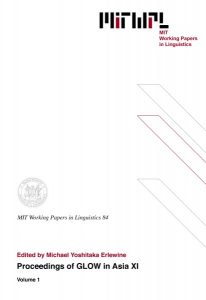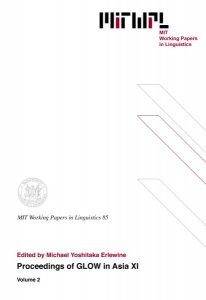The Proceedings of GLOW in Asia XI (volumes 1 and 2), edited by Michael Yoshitaka Erlewine, has been published with MIT Working Papers in Linguistics, 2017.
Table of contents and introduction (PDF)
Volume 1
Extraction Asymmetries in Ergative and Accusative Languages, 1–20
Edith Aldridge
The Japanese Syllable Debate: A Skeptical Look at Some Anti-Syllable Arguments, 21–31
Timothy J. Vance
Definite and Demonstrative Descriptions: A Micro-typology, 33–48
Dorothy Ahn
Speaker Visibility in Syntax, 49–53
Faruk Akkuş and Virginia Hill
Bundling Perfective and Perfect: The Atayal Wal, 65–78
Sihwei Chen
Two Levels for Definiteness, 79–93
Lisa Lai-Shen Cheng, Caroline Heycock, and Roberto Zamparelli
Proxy Control: Extending the Typology of Control in Grammar, 95–109
Aaron Doliana and Sandhya Sundaresan
Variation in Subject-triggered Clitic Restrictions: A Case of Punjabi, 111–126
Gurmeet Kaur
Korean Verbal Base Is Determined Based on Usage, Not Informativeness, 127–140
Taewoo Kim
In-situ Properties of Fragment Answers: Evidence from Japanese, 141–155
Hiroko Kimura and Hiroki Narita
Dou-Quantification, Distributivity, and Alternative Semantics, 157–167
Mingming Liu
What Is Elided in English VbP Ellipsis, and When?, 169–183
Dongwoo Park
It Goes Without Saying: Denegated Negation in Japanese, 185–199
Lukas Rieser
A Unified Account of the Yes/No Particle in Hindi, Bangla, and Odia, 201–212
Saurov Syed and Bhamati Dash
Negative Polarity Items in Malay: An Exhaustification Account, 213–226
Deborah J. M. Wong
Verbal Reduplication in Mandarin Chinese: An Analysis at the Syntax-Phonology Interface, 227–242
Yifan Yang and Wei Wei
Volume 2
Simultaneity in Sign Language: Some Observations From Japanese Sign Language, 1–14
Yuko Asada
Complementizer Allomorphy in Busan Korean, 15–27
Michael Barrie and Hyunjung Lee
On the Ambiguity of Superlative Modifiers, 29–40
Yi-Hsun Chen
Two Kinds of Syntactic Ergativity in Mayan, 41–56
Jamie Douglas, Rodrigo Ranero, and Michelle Sheehan
Eliminating the Strong/Weak Paramater on T, 57–71
Nobu Goto
Focus and Nominal Ellipsis in the Bangla DP, 73–86
Ambalika Guha
Decay of Ungrounded Rules: Middle Korean Vowel Harmony in Contemporary Korean, 87–101
Hayeun Jang
To Exhaust, or Not To Exhaust: An Experimental Study on Mandarin Shi-clefts, 103–117
Ying Liu and Yu’an Yang
Degree Nominals in Japanese and Chinese Comparatives, 119–133
Fumio Mohri and Rai Tei
On Two Ways of External Pair-Merge, 135–146
Tomonori Otsuka
Universals in Pragmatics: Maximize Presupposition and Obligatory Implicatures, 147–161
Agata Renans, Nadine Bade, and Joseph P. De Veaugh-Geiss
Like/Type, Say, and C, 163–177
Hiroaki Saito
Phonemic Instability: A Butterfly Effect, 179–194
Paroma Sanyal and Reena Ashem
Parallelism and Specificity in Persian Non-verbal Element Ellipsis, 195–204
Ryan Walter Smith, Rana Nabors, Mohsen Mahdavi Mazdeh, Simin Karimi, and Heidi Harley
Focusing on Coordination: The Case of Japanese -Toka and -Tari, 205–215
Ryan Walter Smith and Ryoichiro Kobayashi
Anaphors Aren’t Born Equal: Distinct Classes of Anaphor Within an Enriched PERSON System, 217–231
Sandhya Sundaresan
A Compositional Analysis of Plural Morphemes in Japanese, 233–241
Yuta Tatsumi
Rethinking Wh-island Effects in Japanese and Chinese, 243–249
Barry C.-Y. Yang

